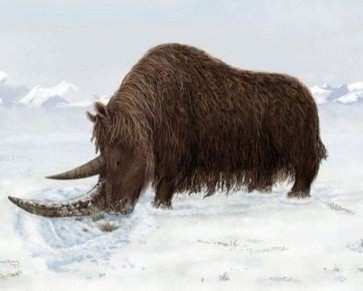Hairy Rhino With Paddle-like Horn Lived Icy Life in Tibet

Paleontologists have unearthed a fossil of a woolly rhinoceros in the Tibetan highlands, which, they believe, could be an ancestor of giant Ice Age mammals that adapted a chilled climate before the Ice Age.
The fossil of the rhino was dug out from the Tibet's Zanda Basin by researchers at the Natural History Museum of Los Angeles County and the Chinese Academy of Science in 2007. They have put the species in a new species classification, named Coelodonta thibetana. According to them, the fossil, found on the Tibetan Plateau, dates to about 3.6 million years ago, and it's the oldest specimen of its kind yet to be found.
The findings, released on Friday in the journal Science, also included vanished species of three-toed horse, Tibetan bharal (also known as blue sheep) and almost 25 other kinds of mammals. Based on results, researchers argue that even before the Ice Age began, the cold Tibetan highlands may have served as an evolutionary cradle for cold-hardy mammals whose successors thrived in the glacial times that followed.
A 3-foot-long skull and lower jaw, along with a neck vertebra were uncovered in southwestern Tibet. Based on the marks on the skull, scientists deduced that the rhino's horn was flattened to form a paddle. The paddle-like horn would have allowed it to dig snow and find vegetation below. Moreover, its teeth had high crowns which enabled the animals to handle tough high altitude vegetation.
These features of the Coelodonta thibetana fossil have led researchers to believe that the frosty Tibetan highlands enabled the rhinos to become accustomed to a cold icy life in the Himalayas and prepared it to spread across Asia when global temperatures plummeted, ushering in the Ice Age, the researchers said.
The cold winters in high Tibet served as a habituation ground for the mega-herbivores, which became pre-adapted for the Ice Age, successfully expanding to the Eurasian mammoth steppe, said study author Xiaoming Wang, from the Natural History Museum of Los Angeles. It just happens to have the right environment to basically let animals acclimate themselves and be ready for the Ice Age cold.
The study said 3.7 million year-old skull would have belonged to animal that weighed 1.2 to 1.4 tons. That's close to the size of modern rhinoceroses and about 10 percent smaller than the woolly rhinos found a million years later during the Ice Age.
Although the extinction of the Pleistocene animals like woolly mammoths, rhinos, great sloths and sabre-tooth cats has been widely studied, there is not much information about where these giants came from and how they acquired their adaptations for living in a cold environment, researchers said in a statement.
When this rhino existed, the global climate was much warmer and the northern continents were free of the massive ice sheets seen in the later ice ages, Wang told BBC. Then, about a million years later, when the ice age did hit the world, these Tibetan woolly rhinos were basically pre-adapted to the ice age environment because they had this ability to sweep snows.
Must Read: Floating Rafts of Volcanic Rock, First Ideal Habitat for Earliest Life on Earth
© Copyright IBTimes 2025. All rights reserved.






















